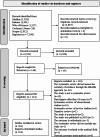Pediatric dentistry systematic reviews using the GRADE approach: methodological study
- PMID: 39003480
- PMCID: PMC11245772
- DOI: 10.1186/s12903-024-04542-w
Pediatric dentistry systematic reviews using the GRADE approach: methodological study
Abstract
Background: To assess the reporting of the certainty of the evidence using the GRADE approach in systematic reviews of interventions in pediatric dentistry.
Methods: The inclusion criteria were systematic reviews of randomized clinical trials (RCTs) and non-randomized studies of interventions (NRSIs) in pediatric dentistry that reported the certainty of the evidence through the GRADE approach. Paired independent reviewers screened the studies, extracted data, and appraised the methodological quality using the Assessing the Methodological Quality of Systematic Reviews (AMSTAR 2) tool. The certainty of the evidence was extracted for each outcome. A descriptive analysis was conducted.
Results: Around 28% of pediatric dentistry reviews of interventions used the GRADE approach (n = 24). Twenty reviews reported 112 evidence outcomes from RCTs and 13 from NRSIs using GRADE evidence profile tables. The methodological quality was high (16.7%), moderate (12.5%), low (37.5%), and critically low (33.3%), fulfilling the majority of the AMSTAR 2 criteria. The certainty of the evidence for outcomes generated from RCTs and NRSIs was very low (40.2% and 84.6%), low (33.1% and 7.7%), moderate (17.8% and 7.7%), and high (9.8% and 0.0%). The main reasons to downgrade the certainty were due to (for RCTs and NRSIs, respectively): risk of bias (68.8% and 84.6%), imprecision (67.8% and 100.0%), inconsistency (18.8% and 23.1%), indirectness (17.8% and 0.0%), and publication bias (7.1% and 0.0%).
Conclusion: The proportion of systematic reviews assessing the certainty of the evidence using the GRADE approach was considered small, considering the total initial number of published pediatric dentistry reviews of intervention. The certainty of the evidence was mainly very low and low, and the main problems for downgrading the certainty of evidence were due to risk of bias and imprecision.
Registration: PROSPERO database #CRD42022365443.
Keywords: Child; Clinical trial; Dental care; Meta-analysis; Oral health; Overview, GRADE approach; Pediatric dentistry; Systematic review.
© 2024. The Author(s).
Conflict of interest statement
The authors declare no competing interests.
Figures
Similar articles
-
Convalescent plasma or hyperimmune immunoglobulin for people with COVID-19: a living systematic review.Cochrane Database Syst Rev. 2020 Oct 12;10:CD013600. doi: 10.1002/14651858.CD013600.pub3. Cochrane Database Syst Rev. 2020. Update in: Cochrane Database Syst Rev. 2021 May 20;5:CD013600. doi: 10.1002/14651858.CD013600.pub4. PMID: 33044747 Updated.
-
The future of Cochrane Neonatal.Early Hum Dev. 2020 Nov;150:105191. doi: 10.1016/j.earlhumdev.2020.105191. Epub 2020 Sep 12. Early Hum Dev. 2020. PMID: 33036834
-
Convalescent plasma or hyperimmune immunoglobulin for people with COVID-19: a living systematic review.Cochrane Database Syst Rev. 2021 May 20;5(5):CD013600. doi: 10.1002/14651858.CD013600.pub4. Cochrane Database Syst Rev. 2021. Update in: Cochrane Database Syst Rev. 2023 Feb 1;2:CD013600. doi: 10.1002/14651858.CD013600.pub5. PMID: 34013969 Free PMC article. Updated.
-
Interventions for escalation of therapy for acute exacerbations of asthma in children: an overview of Cochrane Reviews.Cochrane Database Syst Rev. 2020 Aug 5;8(8):CD012977. doi: 10.1002/14651858.CD012977.pub2. Cochrane Database Syst Rev. 2020. PMID: 32767571 Free PMC article.
-
Interventions for patent ductus arteriosus (PDA) in preterm infants: an overview of Cochrane Systematic Reviews.Cochrane Database Syst Rev. 2023 Apr 11;4(4):CD013588. doi: 10.1002/14651858.CD013588.pub2. Cochrane Database Syst Rev. 2023. PMID: 37039501 Free PMC article. Review.
References
-
- Notaro SQ, Hermont AP, Cruz PV, Maia RM, Avila WM, Poklepovic Pericic T, Abreu LG, Jiao R, Martins-Pfeifer C. Methodological quality of systematic reviews addressing orthodontic interventions: methodological study. Pesq Bras Odontop Clin Int. 2024;24:e230074. doi: 10.1590/pboci.2024.040. - DOI
-
- Pereira AG, Martins CC, Campos JR, Faria SF, Notaro SQ, Poklepovic-Pericic T, Costa LC, Costa FO, Cota LO. Critical appraisal of systematic reviews of intervention studies in periodontology using AMSTAR 2 and ROBIS tools. J Clin Exp Dent. 2023;15(8):e678–94. doi: 10.4317/jced.60197. - DOI - PMC - PubMed
MeSH terms
Grants and funding
- 001/Coordenação de Aperfeiçoamento de Pessoal de Nível Superior
- 001/Coordenação de Aperfeiçoamento de Pessoal de Nível Superior
- 001/Coordenação de Aperfeiçoamento de Pessoal de Nível Superior
- APQ-00323-17/Fundação de Amparo à Pesquisa do Estado de Minas Gerais
- APQ-00323-17/Fundação de Amparo à Pesquisa do Estado de Minas Gerais
LinkOut - more resources
Full Text Sources


